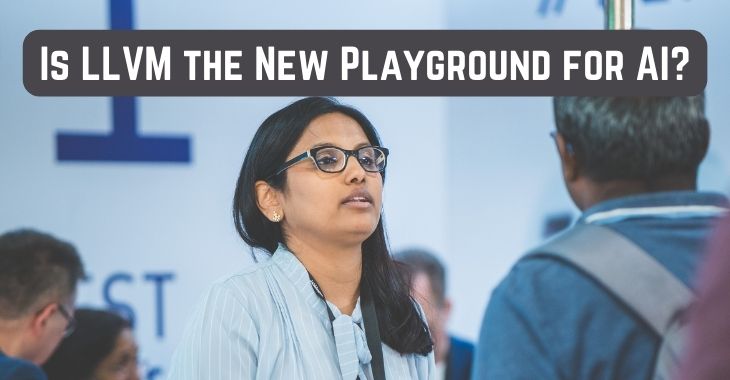
“Once again Saltmarch has knocked it out of the park with interesting speakers, engaging content and challenging ideas. No jetlag fog at all, which counts for how interesting the whole thing was."
Cybersecurity Lead, PwC

The rate of innovation in technology is nothing short of breathtaking. From self-driving cars to virtual personal assistants, artificial intelligence (AI) is redefining the boundaries of what machines can do. However, it's not just the end products that are getting the AI treatment; the tools and technologies behind the scenes are also undergoing a paradigm shift. Enter compiler optimization, a field that has remained relatively stable over the years, mostly relying on human expertise and algorithmic improvements. That stability is now being upended by AI, and interestingly, the open-source LLVM compiler infrastructure is leading this charge.
LLVM, which stands for Low-Level Virtual Machine, is not new to the scene. It's a well-established part of the tech stack that has been instrumental in optimizing code for performance. But what happens when you infuse LLVM with AI capabilities? The result is a powerful synergy that could redefine code optimization and, by extension, software development.
Why is this integration so groundbreaking? Is LLVM becoming the new playground for AI? In this article, we will deep-dive into this emerging trend, exploring its history, practical implications, and what it could mean for the future of technology.
A Brief History of LLVM
In the early 2000s, the computing world was largely dominated by a few key compiler technologies. But the launch of LLVM in 2003 marked a significant shift. Created by Chris Lattner as part of his research project at the University of Illinois, LLVM initially aimed to provide a more modular and flexible approach to compiler design.
Fast forward to today, and LLVM has become an integral part of the modern tech stack. What started as a research project has transformed into a robust, open-source compiler infrastructure that supports a multitude of programming languages, including C, C++, Rust, and Swift. Its modular architecture has made it a favorite among developers, allowing them to mix and match various components to create custom compilation pipelines.
But it's not just the flexibility that sets LLVM apart; it's the vibrant community of developers and contributors who continuously push its capabilities. Over the years, this community has added optimizations, debuggers, and even support for WebAssembly, making LLVM a one-stop-shop for compiler needs.
Perhaps most notably, LLVM has played a crucial role in enabling the development of languages like Rust and Swift, which prioritize safety and performance. It's this focus on adaptability and forward-thinking that has set the stage for LLVM's latest venture: its integration with artificial intelligence.
The significance of LLVM goes beyond its features and community; it represents a philosophy of openness and adaptability, a framework that's ever-ready to embrace the next wave of technological advancements. As we venture into the era of AI, LLVM seems poised to become an even more pivotal tool in the software development landscape.
Why LLVM?
When pondering why LLVM has become the focus for AI-driven compiler optimization, several factors come into play. At the core is LLVM's modular architecture, which allows for targeted optimizations at different stages of the compilation process. Unlike monolithic compilers, LLVM's modular design offers a high degree of customization, enabling developers to plug in new optimization techniques as they emerge. This design principle makes it an ideal candidate for AI-based interventions, which often require a flexible environment to fully realize their potential.
Another reason LLVM stands out is its widespread industry adoption. Companies like Apple, Google, and Microsoft rely on LLVM for various tasks, ranging from developing new programming languages to optimizing existing ones for performance and power efficiency. This broad usage provides a fertile testing ground for AI algorithms, giving them a real-world environment where they can be trained and evaluated.
Data availability also plays a significant role. LLVM has a rich ecosystem of libraries, tools, and extensions, providing a wealth of data that can be used for training machine learning models. This abundance of data is essential for the sophisticated algorithms that power AI-driven compiler optimizations. Besides, LLVM's open-source nature fosters a collaborative environment, encouraging contributions from both academia and industry. This synergy is especially important in the rapidly evolving field of AI, where the exchange of ideas and techniques can accelerate progress exponentially.
But perhaps the most compelling reason is the sheer complexity of modern software. As applications grow more intricate, the task of optimizing them becomes increasingly challenging. Traditional methods can only go so far, and that's where AI comes in. With its capability to sift through vast datasets and identify intricate patterns, AI offers a level of optimization that was previously unattainable.
LLVM's modular architecture, industry adoption, data availability, collaborative environment, and the complexity of modern software all converge to make it a prime playground for AI-based innovations. As we'll see in the next sections, this is not mere speculation; tangible advancements are already being made.
The 7B-Parameter Transformer Model
The concept of using machine learning models for compiler optimization isn't entirely new, but the scale at which it is now being pursued is groundbreaking. A recent research study introduced a 7B-parameter transformer model specifically trained to optimize LLVM assembly code. To put this in perspective, the model's complexity is on par with some of the largest natural language processing models used by tech giants like Google and OpenAI.
So, what makes this model stand out? First and foremost, it's the sheer scale and the level of fine-tuning involved. Trained on a vast dataset comprising LLVM assembly code, the model has shown remarkable results in optimizing code for size, and preliminary results suggest that it could even outperform traditional methods.
However, the real magic lies in the model's adaptability. Unlike traditional compiler optimizations that are rule-based and relatively static, the AI model can dynamically adjust its strategies based on the specific challenges presented by the code it's optimizing. This dynamism opens up new possibilities for highly customized optimizations that were previously unfeasible.
Another intriguing aspect is the potential for 'transfer learning.' The model, initially trained on LLVM, could be adapted to work with other compiler infrastructures or even entirely different domains. This cross-applicability adds another layer of intrigue, making the model not just a tool for LLVM but potentially a universal optimizer.
Of course, the model is not without its challenges, which we will explore later. But its initial successes suggest a paradigm shift in how we think about compiler optimization. Gone are the days when static, rule-based algorithms were the only option. The 7B-parameter transformer model is a harbinger of what's possible when we leverage AI's full capability.
The Practical Implications
As fascinating as the technology is, the ultimate test of its value lies in its real-world applications. So what are the practical implications of integrating AI into LLVM? To start with, let's talk about speed. Traditional compiler optimization methods are painstakingly manual and time-consuming. They often involve multiple iterations and fine-tuning, requiring a significant investment of human resources. AI changes this dynamic dramatically. With its ability to process and analyze large sets of data rapidly, AI can achieve levels of optimization in a fraction of the time it would take a human.
But speed is just the tip of the iceberg. The quality of optimization is also a game-changer. Early results from the 7B-parameter transformer model suggest that AI can achieve levels of optimization that either match or exceed current methods. This could have a ripple effect across the entire software ecosystem, from operating systems to applications, resulting in software that's not just faster but also more efficient.
The adaptability of AI also opens up new avenues for specialized optimization. For instance, AI could tailor the optimization process for specific hardware configurations, ensuring that software runs optimally on a variety of devices, from smartphones to data centers. This level of customization was previously challenging to achieve with traditional, rule-based methods.
Another exciting implication is in the realm of software security. While this is a double-edged sword—a topic we'll delve into later—the potential for AI to identify and eliminate security vulnerabilities during the compilation process should not be overlooked.
Finally, the integration of AI into LLVM could democratize the field of compiler optimization. Traditionally, this has been a niche area requiring specialized knowledge. AI could simplify the process, making advanced optimization techniques accessible to a broader range of developers.
In essence, the practical implications of AI integration in LLVM are vast, touching on aspects from speed and efficiency to customization and security. It represents not just an incremental improvement but a potential revolution in how we approach software development.
The Ethical Angle
As we marvel at the technological advancements that AI brings to LLVM and compiler optimization, it's imperative not to lose sight of the ethical considerations. The first question that comes to mind is job displacement. If AI can optimize code more efficiently and quickly than human experts, what happens to the roles traditionally filled by those experts? While it's true that technology often creates new jobs even as it makes old ones obsolete, the transition can be painful and fraught with challenges.
Another concern is the 'black box' nature of AI algorithms. While the 7B-parameter transformer model can achieve remarkable results, it's often unclear how it arrives at its decisions. This opacity can be a significant issue, especially when we're dealing with mission-critical or safety-sensitive software. Without a clear understanding of how decisions are made, it becomes difficult to fully trust the system, regardless of its performance.
Then there's the issue of data privacy. Training these AI models requires vast amounts of data, often sourced from various projects and repositories. While LLVM is open-source, the ethical implications of using this data—especially if it includes proprietary or sensitive information—cannot be overlooked.
Lastly, there's a potential for bias. Like any machine learning model, the AI algorithms used for compiler optimization are only as good as the data they're trained on. If that data is skewed or incomplete, the resulting optimizations could introduce unintended biases into the software, affecting its performance and reliability in unpredictable ways.
While ethical considerations may not dampen the technological enthusiasm, they do add a layer of complexity that the tech community needs to address proactively. As we push the boundaries of what's possible with LLVM and AI, we must also ensure that we're navigating this new terrain responsibly and ethically.
Challenges and Limitations
As we extol the virtues of AI-driven compiler optimization in LLVM, it's essential to acknowledge that this technology is not a silver bullet. Several challenges and limitations need to be considered.
Firstly, let's talk about the elephant in the room: interpretability. AI models, especially complex ones like the 7B-parameter transformer, often operate as 'black boxes,' making it difficult to understand the rationale behind their decisions. This lack of transparency is a significant concern, especially in industries that require rigorous documentation and traceability, such as healthcare, aviation, and finance.
Another challenge is computational cost. Training a model as expansive as the 7B-parameter transformer requires immense computational power, not to mention the environmental impact of such energy-intensive operations. While the benefits of faster and more efficient software are clear, the trade-offs in terms of resource usage cannot be ignored.
Scalability also poses a concern. While early tests show promise, scaling these AI models to handle large, complex software projects remains an open question. Traditional compiler optimization techniques have decades of research backing their scalability; AI-based methods are relatively new and untested in this regard.
Then there's the issue of dependency. Relying heavily on AI for compiler optimization could make the software development process overly dependent on these complex models, potentially creating a bottleneck if the models fail or produce suboptimal results.
Lastly, there's the challenge of keeping the AI models up-to-date. The field of machine learning is advancing at a breakneck speed, and models can quickly become obsolete. Constant updates and retraining would be required to keep the system performing at its peak, adding another layer of complexity to its maintenance.
While the application of AI in LLVM compiler optimization holds immense promise, it's not without its set of challenges and limitations. As with any disruptive technology, a careful and considered approach will be essential to harness its full potential while mitigating its downsides.
The Road Ahead
As we stand on the cusp of a new era in compiler optimization, fueled by the integration of AI into LLVM, it's worth taking a moment to consider what the future holds. While it's tricky to predict the exact trajectory of technological advancements, several trends and opportunities are worth exploring.
First, there's the notion of 'continuous optimization.' Traditionally, compiler optimization is a one-time process, generally performed during the software development cycle. However, AI could allow for ongoing, real-time optimization, adapting to changes in the software and hardware environment. This shift would make software more resilient and efficient, capable of self-tuning to deliver optimal performance under varying conditions.
Next, we could see the emergence of specialized AI models tailored for different aspects of compiler optimization, such as power efficiency, security, or specific hardware architectures. The modular nature of LLVM makes it an ideal platform for such specialized models, allowing developers to select the most suitable optimization strategies for their particular use-cases.
Collaboration between academia and industry is also likely to intensify. The current advancements in AI-driven compiler optimization stem from a fusion of academic research and real-world applications. This synergy could accelerate even more, leading to rapid advancements and perhaps even the formulation of new theories and methodologies in compiler design.
Moreover, we could see AI models becoming more transparent and interpretable, thanks in part to ongoing research in explainable AI. As these models become less of a 'black box,' their adoption in mission-critical applications could increase, broadening their impact and utility.
Lastly, the integration of AI into LLVM might serve as a blueprint for other areas of software development. The lessons learned and best practices developed could be applied to other domains, potentially revolutionizing how we approach problems in software engineering at large.
In essence, the road ahead is paved with opportunities and challenges. As we continue to push the boundaries of what's possible with LLVM and AI, it will be exciting to see how this technology reshapes the landscape of compiler optimization and software development in the coming years.
Conclusion
As we navigate the intricate maze of technological advancements, the integration of AI into LLVM for compiler optimization stands out as a pivotal moment. It's not merely about making existing processes faster or more efficient; it's about redefining the very paradigms that have governed software development for decades. LLVM, with its open, modular architecture, serves as an ideal platform for this transformation, while AI, with its unparalleled analytical prowess, acts as the catalyst.
What we're witnessing is a marriage of two revolutionary technologies, each amplifying the other's strengths. From achieving unprecedented levels of code optimization to democratizing complex compiler techniques, the possibilities are vast and far-reaching. But as we forge ahead, it's crucial to navigate the ethical and practical challenges with caution and foresight. Whether it's the risk of job displacement, the opacity of AI algorithms, or the sustainability of computational resources, each challenge presents an opportunity for responsible innovation.
The future is rife with both challenges and opportunities. The integration of AI into LLVM isn't just a technological feat; it's a glimpse into a future where software is not just created by humans, but also continually refined by intelligent algorithms. As this future unfolds, it will be our collective responsibility to ensure that we harness this power judiciously, steering it in directions that benefit not just the tech community but society at large.
References: This article was inspired by and draws upon the findings of a recent research paper from authors at Cornell University. The paper delves into the intricacies of AI-driven compiler optimization in LLVM and provides valuable insights that served as the foundation for this article.
Have questions or comments about this article? Reach out to us here.
Banner Image Credits: Attendees at Great International Developer Summit

“Once again Saltmarch has knocked it out of the park with interesting speakers, engaging content and challenging ideas. No jetlag fog at all, which counts for how interesting the whole thing was."
Cybersecurity Lead, PwC

“Very much looking forward to next year. I will be keeping my eye out for the date so I can make sure I lock it in my calendar."
Software Engineering Specialist, Intuit

“Best conference I have ever been to with lots of insights and information on next generation technologies and those that are the need of the hour."
Software Architect, GroupOn

“Happy to meet everyone who came from near and far. Glad to know you've discovered some great lessons here, and glad you joined us for all the discoveries great and small."
Web Architect & Principal Engineer, Scott Davis

“Wonderful set of conferences, well organized, fantastic speakers, and an amazingly interactive set of audience. Thanks for having me at the events!"
Founder of Agile Developer Inc., Dr. Venkat Subramaniam

“What a buzz! The events have been instrumental in bringing the whole software community together. There has been something for everyone from developers to architects to business to vendors. Thanks everyone!"
Voltaire Yap, Global Events Manager, Oracle Corp.